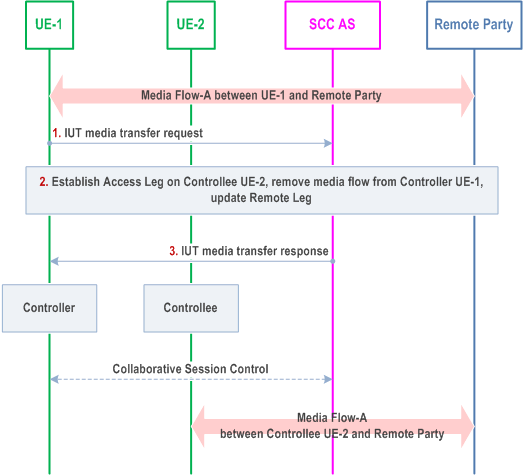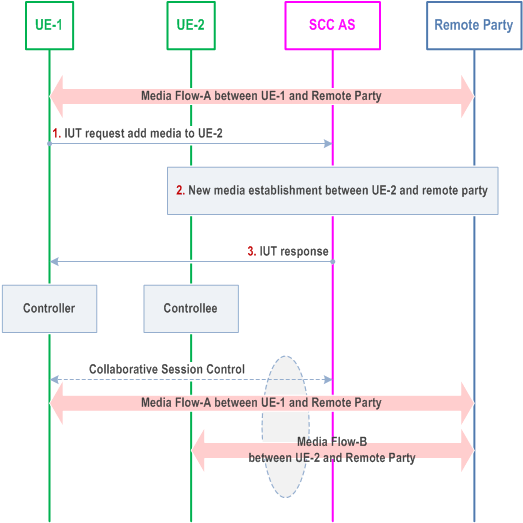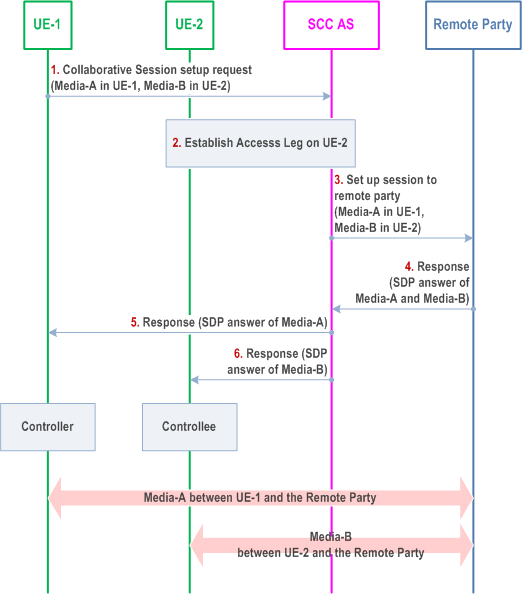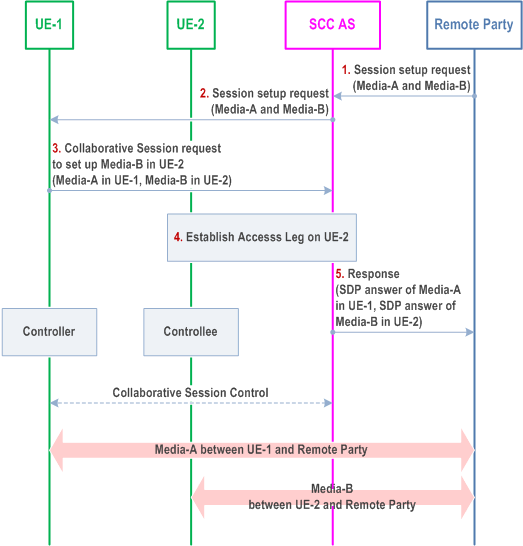Content for TS 23.237 Word version: 18.0.0
0…
4…
5…
5.4…
6…
6.2…
6.2.2…
6.3…
6.3.2…
6.3.2.1.3…
6.3.2.1.7…
6.3.2.1.9…
6.3.2.2…
6.3.2.3…
6.3.2.3.6…
6.3.3…
6.4…
6a…
6a.3…
6a.4…
6a.4.3…
6a.4.5…
6a.4.7…
6a.4a…
6a.5…
6a.6…
6a.7…
6a.8…
6a.9…
6a.10…
6a.11…
6c…
7…
A…
B…
C…
6a Procedures and flows for Inter-UE Transfer
6a.0 Introduction
6a.1 IUT general procedures
6a.2 Information flows for Collaborative Session establishment
6a.2.1 Establish Collaborative Session by transferring media
6a.2.2 Establish Collaborative Session with new media
6a.2.3 Establish Collaborative Session at originating IMS session setup
6a.2.4 Establish Collaborative Session at terminating IMS session setup
...
...
6a Procedures and flows for Inter-UE Transfer |R9| p. 106
6a.0 Introduction p. 106
In the following procedures and flows the UEs involved in IUT are labelled as UE-1, UE-2, etc. while the remote endpoint of the session is labelled as Remote Party. Flows are shown for IUT procedures establishing Collaborative Sessions as well as IUT procedures without establishing a Collaborative Session.
In the following information flows, when initiating IUT Media Control Related Procedures, the Controller UE can be replaced by the Controllee UE with IUT capabilities, with the difference that the Hosting SCC AS receiving a media control request from a Controllee UE with IUT capabilities shall send it to the Controller UE for authorization, or authorize it on behalf of the Controller UE (e.g. based on the user preferences associated with the Controller UE).
These information flows exemplify IUT procedures initiated by a UE sending a request received by the SCC AS. Scenarios pertaining to the SCC AS initiating IUT procedures based on different stimuli such as user preferences, other IMS signalling or service layer triggers are not precluded, but illustrative information flows are not included in this document except for the case of loss of Controller UE.
For the enablement of Inter-UE Transfer, originating and terminating sessions (without Collaborative Session establishment) are handled as specified in clause 6.2.
6a.1 IUT general procedures p. 106
6a.1.1 General p. 106
In all general IUT procedures the sessions are anchored in an SCC AS. These procedures do not apply for emergency sessions.
6a.1.2 Remote Leg Update p. 106
Remote Leg Update for IUT procedures are executed as shown in Figure 6.3.1.5-1 and Figure 6.3.1.5-2, in which the media descriptions applicable after the IUT procedure are communicated to the remote end. For an IUT procedure without establishing a Collaborative Session, the information of the new local end which continues the session with the remote end is also included.
6a.2 Information flows for Collaborative Session establishment p. 106
6a.2.1 Establish Collaborative Session by transferring media p. 106
There is an ongoing session between UE-1 and a remote party, which is anchored at the SCC AS. UE-1 transfers the media flow from UE-1 to UE-2 to establish a Collaborative Session. Following is an information flow for the Collaborative Session establishment procedure when UE-1 initiates media transfer from UE-1 to UE-2. After the transfer, the UE-1 becomes Controller UE, and UE-2 becomes Controllee UE.

Step 1.
When the above transfer is completed the SCC AS retains the service state (e.g. media flows status) of UE-1 and UE-2, and UE-1 retains the control of the Collaborative Session.
UE-1 sends an IUT media transfer request to the SCC AS to transfer Media Flow-A from UE-1 to UE-2. The IUT media transfer request shall include the enough information for the SCC AS to:
Step 2.
- identify that the transferred media flow is Media Flow-A;
- identify that the target of the transferred media flow is UE-2;
- keep the control of the Collaborative Session in UE-1.
The SCC AS performs authorization as specified in clause 6a.12, then sends request to establish Access Leg at UE-2 for Media Flow-A. The SCC AS removes Media Flow-A from UE-1, and updates the Remote Leg using the Remote Leg Update procedure as specified in clause 6a.1.2.
Step 3.
The SCC AS sends an IUT media transfer response to UE-1. A Collaborative Session is established, for which UE-1 becomes the Controller UE and UE-2 becomes a Controllee UE.
6a.2.2 Establish Collaborative Session with new media p. 107
The following information flow shows the Collaborative Session establishment procedure. There is an ongoing IMS session with Media Flow-A between UE-1 and a remote party, which is anchored at the SCC AS. UE-1 wants to add a new Media Flow-B on another UE-2 to the current ongoing IMS session to establish a Collaborative Session.

Step 1.
UE-1 decides to add a new Media Flow-B to UE-2. It sends an IUT add media request to the SCC AS, indicating that a new Media Flow-B will be added to UE-2. The request shall include enough information for the SCC AS to:
Step 2.
- identify that the added media flow is Media Flow-B;
- identify that the target of the added media flow is UE-2;
- keep the control of the Collaborative Session in UE-1;
The SCC AS performs authorization as specified in clause 6a.12, then sends the IUT add media request to UE-2, indicating that a new Media Flow-B will be created on UE-2. Media Flow-B between UE-2 and remote party is established. The Remote Leg is updated accordingly.
Step 3.
After the successful establishment of the Media Flow-B on UE-2, the SCC AS sends an IUT add media response back to UE-1. A Collaborative Session is established, for which UE-1 becomes the Controller UE and UE-2 becomes a Controllee UE and Media Flow-A and Media Flow-B become part of the Collaborative Session under the control of UE-1..
6a.2.3 Establish Collaborative Session at originating IMS session setup |R10| p. 108
The following information flow shows the Collaborative Session establishment procedure when there is no ongoing IMS session. Concurrent with a normal session set-up towards a remote party, UE-1 wants to establish a Collaborative Session, which is anchored at the SCC AS, with a new Media Flow-A on itself and a new Media Flow-B on another UE-2.

Step 1.
After the above operation, a Collaborative Session is established, for which UE-1 becomes the Controller UE and UE-2 becomes a Controllee UE. Media-A is established between Controller UE-1 and the remote party, and Media-B is established between Controllee UE-2 and the remote party.
UE-1 sends an IUT request to the SCC AS in order to set up a Collaborative Session to remote party with Media-A in UE-1, and with Media-B in UE-2. The session setup request shall include enough information for the SCC AS to:
Step 2.
- identify the remote party of the session setup request;
- identify that Media-A shall be established in UE-1;
- identify that Media-B shall be established in UE-2 and the requested media type associated with Media-B (e.g. video);
- keep the control of the Collaborative Session in UE-1.
The SCC AS performs authorization as specified in clause 6a.12, then sends a request to establish an Access Leg at UE-2 for Media-B.
Step 3.
The SCC AS sends a session setup request to the remote party.
Step 4.
The remote party sends a response with the SDP answer of Media-A and Media-B to the SCC AS.
Step 5.
The SCC AS sends a response with the SDP answer of Media-A to UE-1 to establish Media-A in UE-1.
Step 6.
The SCC AS sends a response with the SDP answer of Media-B to UE-2 to establish Media-B in UE-2.
6a.2.4 Establish Collaborative Session at terminating IMS session setup |R10| p. 110
The following information flow shows the Collaborative Session establishment procedure when there is no ongoing IMS session. Concurrent with the response to a normal session invitation received from a remote party, UE-1 wants to establish a Collaborative Session, which is anchored at the SCC AS, with the requested Media Flow-A on itself and the requested Media Flow-B on another UE-2.

Step 1.
After the above operation, a Collaborative Session is established, for which UE-1 becomes the Controller UE and UE-2 becomes a Controllee UE. Media-A is established between Controller UE-1 and the remote party, and Media-B is established between Controllee UE-2 and the remote party.
The remote party sends a session setup request to the SCC AS to set up Media-A and Media-B with UE-1.
Step 2.
The SCC AS forwards the session setup request to UE-1.
Step 3.
UE-1 sends a Collaborative Session request to the SCC AS to setup Media-B in UE-2. The session setup request includes enough information for the network to:
Step 4.
- identify that Media-B shall be established in UE-2 and the requested media type associated with Media-B (e.g. video);
- keep the control of the Collaborative Session in UE-1.
The SCC AS performs authorization as specified in clause 6a.12, then sends a request to establish an Access Leg at UE-2 for Media-B.
Step 5.
The SCC AS sends a response to the remote party. The response carries the SDP answer of Media-A in UE-1 and Media-B in UE-2.